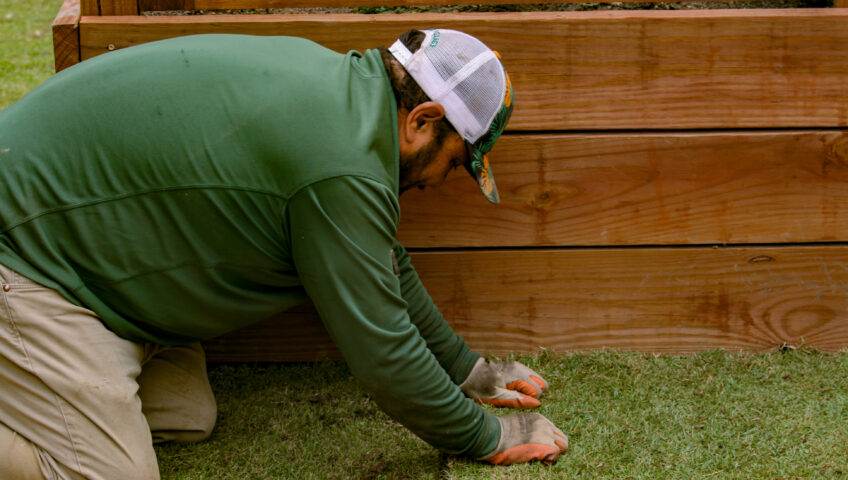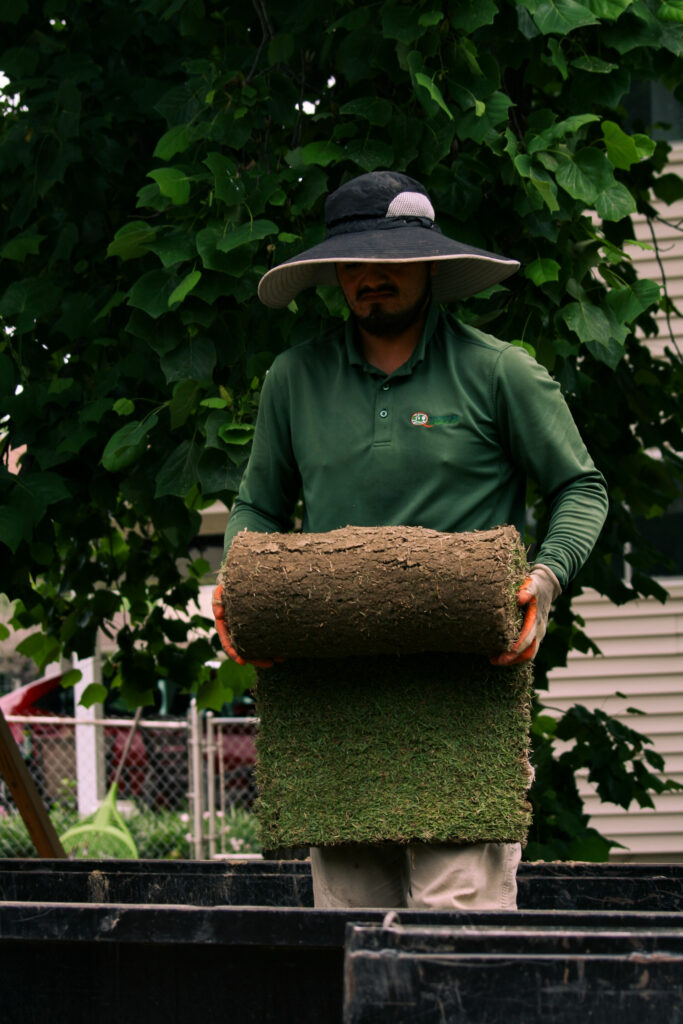
Welcome to Your New Lawn: What to Do After Sod Installation
You’ve just invested in a beautiful new sod lawn – congratulations! As the hero of your lawn’s story, you’ve taken the first big step by choosing instant green grass. Now it’s time for the next chapter: helping that new sod take root and thrive. Don’t worry – Quiet Village Landscaping is here as your guide to walk you through caring for your fresh sod. In this post, we’ll cover everything from how sod is installed, to the best watering schedule, mowing timeline, and pro tips to keep your sod alive and healthy. By following these guidelines (and leaning on us when you need help), you’ll be on your way to a lush, green lawn in no time. Let’s dive in!
Why New Sod Needs Special Care (Immature Roots and Moisture)
New sod comes with only a thin base of roots and soil, so it relies on that shallow root system at first. Unlike an established lawn, it can’t tap into deeper ground moisture yet – all its water must come from the surface.
During these first critical weeks, your sod is very vulnerable to drying out. Skipping even one or two days of watering in hot weather could spell disaster for new sod. On the other hand, overwatering can be harmful too (sod roots need oxygen). The goal is to keep the sod consistently damp but not drowning.
In the sections below, we’ll outline exactly how to water new sod, including the best times of day, frequency, and adjustments for each season. With the right watering plan, your sod will soon be as hardy as a regular lawn.
How to Water New Sod for a Healthy Lawn
Water Immediately After Installation: As soon as your sod is installed (that same day), give it a good, deep watering. The goal is to soak both the sod and the soil beneath it down to ~6 inches deep. This initial soaking helps “connect” the sod to the underlying soil and eases the shock of transplanting. (If Quiet Village installed your sod, we did this first watering for you before we left.)
Keep the Sod Consistently Moist (First 2 Weeks): New sod needs water at least twice a day for the first two weeks. Plan to water every morning and again in the late afternoon to keep the grass damp at all times. Do not let your new sod dry out during this period! In fact, on very hot or windy days, you might even need to water three times a day. For example, in the heat of summer (90°F+), adding a midday watering (around lunch time) can help prevent the sod from drying out.
How Long to Water New Sod: Many new sod owners wonder how long to water each time. As a general guide, run sprinklers for about 20-30 minutes in each watering session. However, the right duration can vary based on your sprinkler type and water pressure.
Best Time of Day to Water Sod: The early morning is the best time to water new sod. Morning (ideally around sunrise) has cooler temperatures and gentler sun, so more water soaks into the soil rather than evaporating away. Morning watering also gives the grass blades time to dry off in the sun later, which helps prevent disease. If you’re doing two or three waterings per day, schedule the second watering in the late afternoon (e.g. mid-to-late afternoon, a few hours before sunset). This provides another drink before the evening, but try to avoid watering too late at night – leaving the sod waterlogged overnight can encourage fungal diseases.
Watch the Corners and Edges: The edges of each sod roll (along driveways, sidewalks, and the perimeter of your lawn) tend to dry out faster than the center areas. These spots can be “hot zones” that don’t retain moisture as well. Pay special attention to them – you may need to give edges and corners a little extra water by hand.
Manual Watering vs. Sprinkler System: Watering new sod by hand with a hose or a movable sprinkler is doable, but be prepared – it’s a big time commitment to water properly this way. You’ll need to be very diligent about those multiple daily waterings. If you’re not home during the day or worry you’ll miss waterings, consider investing in a timer for your sprinkler or, better yet, an automatic irrigation system. In fact, we highly recommend having a sprinkler system in place when you install sod, because of the intense watering needs early on and to ensure even coverage. If you don’t have an irrigation system, Quiet Village Landscaping offers irrigation system installations and recurring irrigation maintenance.
Watering Schedule for New Sod (By Season)
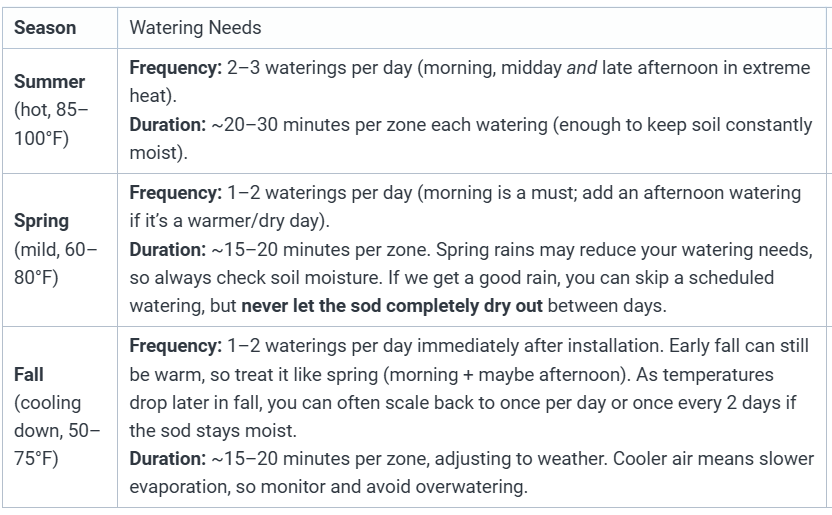
Note: Always adjust your watering if Mother Nature helps out. Rainfall counts towards the sod’s water needs – you can often skip or shorten watering on rainy days, just ensure the rain was sufficient. On the flip side, don’t skip watering during dry spells, even in cooler weather. Windy days can dry out sod quickly, so consider an extra watering if it’s very breezy. rooftops
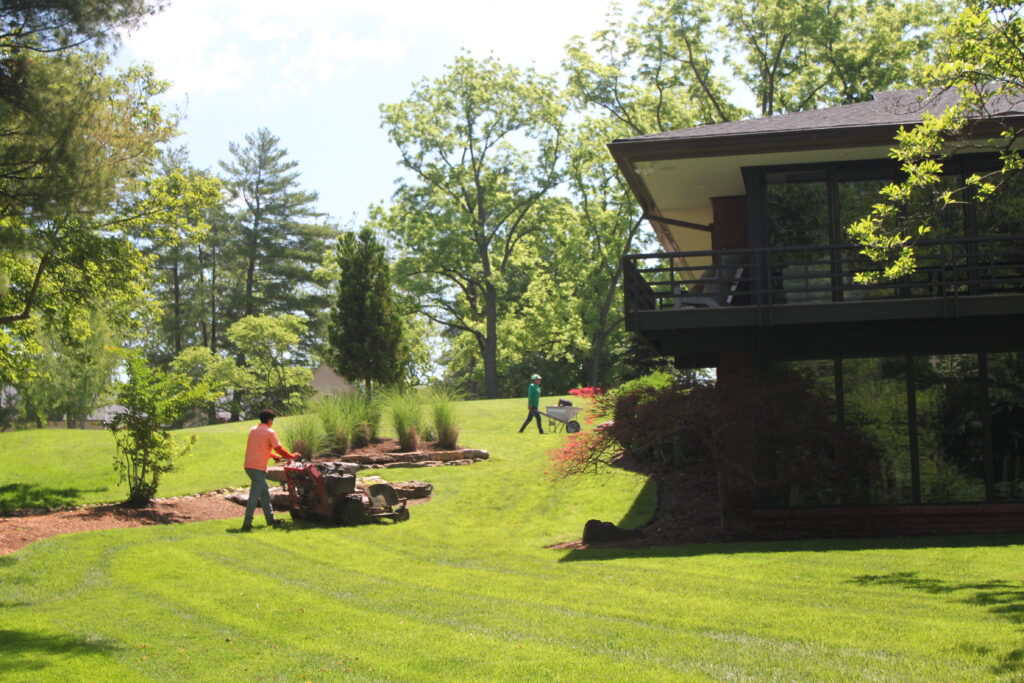
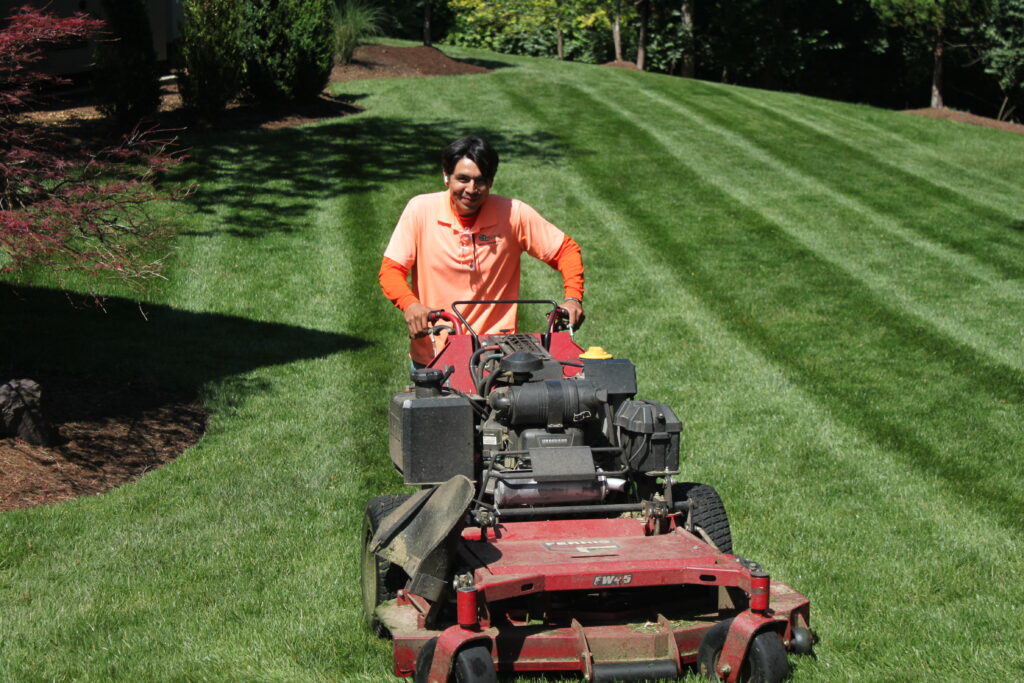
When Can I Mow New Sod?
A common question we hear is: “When can I mow sod after installation?” We know you’re excited to see a neatly trimmed lawn, but hold off on mowing for a little while. New sod is delicate and needs time to put down roots before it gets cut. Generally, you should wait about 2–3 weeks after installation before doing the first mow. The exact timing can depend on how fast your sod is rooting and growing. Here’s how to tell if your sod is ready to mow:
Rooting Test: Before mowing, do a quick check – gently tug up on the edge of a sod strip. If the sod still lifts up easily like a loose carpet, the roots haven’t anchored yet and it’s too soon to mow. If you feel resistance and the sod stays down, that means roots have begun to take hold in the soil. Once the sod is rooted enough that it doesn’t peel up from the ground, it can handle a mower without being torn up.
Mow High & Sharp: When you do mow new sod for the first time, set your mower blade to the highest setting. You want to cut the grass high, removing only the top 1/3 of the blade length. For example, if the grass is 4.5 inches tall, mow it down to about 3 inches. This avoids stressing the grass too much. Make sure your mower blades are sharp – dull blades can tug and rip the young grass instead of cleanly cutting it. Quiet Village Landscaping offers moving services to select St. Louis areas for your help & peace of mind.
Additional Tips to Keep Your Sod Healthy
By now, you’ve learned that watering and patience are the keys to sod success. Before we wrap up, here are a few extra tips on how to keep your new sod alive and thriving:
Stay Off the Sod (At First): Minimize traffic on the lawn for the first couple of weeks. Avoid heavy use, furniture placement, or pet/ kid play on the fresh sod. The ground is soft from all that watering, and heavy footsteps or dog paws can create ruts or uneven spots. After about 3 weeks, you can gradually return to normal use.
Fertilizer and Weed Control: New sod typically comes fertilized from the farm, and you won’t need to fertilize again for at least 6–8 weeks after installation. Applying fertilizer too early can burn the young roots or encourage top growth before the roots are ready. Likewise, avoid using herbicides or weed killers on new sod for at least the first 1–2 months. Your Quiet Village maintenance team can handle any needed fertilization and weed control at the appropriate times, as part of our lawn care program. Initially, just focus on water and mowing – let the sod get established.
Monitor Daily: It’s a good idea to walk your lawn each day (briefly, and gently) to inspect how the sod is doing. This way, you’ll catch any problems early. Look for areas that are drying out (you might see the sod edges curling or lifting, or the color dulling). Also look for any overwatered spots. Spend an extra minute watering any dry corners by hand, or dial back the sprinklers if you see puddles.
Gradually Adjust Watering: After the first two weeks of intensive watering, you can start to back off a bit. Your sod’s roots will be growing deeper, and the weather may guide you too. Starting around week 3 or 4, you can transition to an “established lawn” watering routine: that usually means watering about 1 to 1.5 inches per week total. This might look like watering 2–3 times per week for longer periods, rather than every day. However, make this shift gradually – don’t go from watering three times a day to three times a week overnight. Wean the sod off the frequent water over a week or two (e.g., go from 2x a day to 1x a day, then to every other day, etc.), while watching that it doesn’t wilt. If it starts to get limp or dry between waterings, bump the frequency back up a bit. By the one-month mark, your new sod should be well on its way to behaving like a regular lawn.
Make Caring for Sod Easy – Quiet Village Is Here to Help
We know this is a lot of information, but you’re not in it alone. Our mission is to support you and ensure your new sod thrives.
Need help with watering? Quiet Village offers professional irrigation services that can take the hassle out of keeping your sod hydrated. We install state-of-the-art sprinkler systems and can customize them for your property’s needs. An automatic irrigation system saves you time and delivers the right amount of water consistently – it’s like having a personal lawn caretaker on a timer. If you already have an irrigation system, we also provide full irrigation maintenance and tune-ups (adjusting sprinkler heads, setting controllers, backflow inspections, winterization, etc.) to make sure your system runs smoothly year-round.
If we installed your sod and maintain your irrigation, we’ll be happy to check on your sod during the first few weeks to ensure it’s establishing properly.
In conclusion, caring for new sod is all about consistency and support. You’ve made a heroic choice to upgrade your lawn, and with diligent watering and care, you’re well on your way to victory – a healthy, beautiful lawn that will make your neighbors green with envy. Stay patient in those first weeks, follow the tips in this guide, and don’t hesitate to ask for help if you need it. We’re here to guide you every step of the way. Congratulations again on your new sod, and here’s to many years of a green, healthy lawn!
Ready to optimize your watering or need expert lawn care? Contact Quiet Village Landscaping anytime – we’re excited to support you in achieving the lawn of your dreams!
Follow Us on Social Media for More Inspiration

